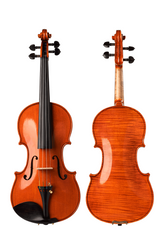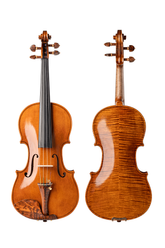Why Does a Violin Produce a Wolf Tone?
The wolf tone is a peculiar acoustic phenomenon that occurs during violin performance. It is often described as an unstable, wobbly, or buzzing sound, resembling a wolf’s howl. Typically appearing on higher positions of the G string, it can also occur on other strings at certain pitches. This phenomenon arises from the interplay of the violin’s physical structure, its strings, and the way they vibrate. Below, we explore the causes of wolf tones and discuss potential solutions.
The Mechanism Behind Wolf Tones
Resonance Conflict Between the Violin Body and Strings
The violin’s body acts as a resonance chamber, amplifying the vibrations of its strings. When the body’s natural resonance frequency closely matches the string’s vibration frequency, an unstable vibration pattern can form. This overlap amplifies resonance to a chaotic degree, producing the wolf tone.
Harmonic Characteristics of Strings
Different string materials and tensions affect resonance in unique ways:
- Synthetic core strings tend to produce smoother vibrations, making them less prone to wolf tones.
- Steel core strings, on the other hand, generate stronger, more stable vibrations that may amplify resonance conflicts.
Improperly tuned strings—too tight or too loose—can also increase the likelihood of triggering a wolf tone.
The Role of the Bridge and Saddle
The bridge, a critical component transmitting string vibrations to the violin’s body, influences resonance. If improperly placed or designed, the bridge can enhance certain resonant frequencies, causing wolf tones. Similarly, the saddle (the point where the tailpiece connects to the body) may exacerbate resonance issues if tension is unevenly distributed.
Soundpost Placement
The soundpost, a small wooden rod inside the violin, controls the instrument’s resonance. A misplaced or improperly tensioned soundpost can alter vibration patterns, increasing the risk of a wolf tone.
Material and Structural Characteristics
The violin’s construction significantly impacts resonance:
- Wood quality: Uneven wood density can result in excessive resonance.
- Craftsmanship: Handcrafted violins generally manage resonance better than mass-produced ones, leading to fewer wolf tones.
- Aging: Older violins may develop imbalances in resonance due to material fatigue, making them more prone to wolf tones.
Playing Technique
The player’s bowing technique also influences wolf tones. Excessive bow pressure or speed can overstimulate the strings, while slight changes in bow placement may alter energy transfer, affecting the intensity of the wolf tone.
How to Resolve or Minimize Wolf Tones
Use a Wolf Tone Eliminator
A wolf tone eliminator is a small device, typically made of metal or rubber, that attaches between the bridge and string. It modifies vibration patterns to reduce resonance conflicts and is one of the most effective tools for managing wolf tones.
Adjust the Soundpost
Slight adjustments to the soundpost’s position can alter the violin’s vibration response, reducing problematic resonances. However, this should only be done by a professional luthier to prevent damage or compromise to the instrument’s sound.
Choose Suitable Strings
Replacing strings can significantly impact wolf tones:
- Synthetic core strings (e.g., Dominant) often reduce wolf tones.
- Lower-tension strings are also effective in minimizing excessive resonance.
Correct the Bridge and Saddle Position
Ensure the bridge is properly positioned and stands upright. The saddle should distribute tension evenly to prevent interference with low-frequency vibrations.
Seek Professional Adjustment
In severe cases, consult a professional luthier for structural adjustments, such as recalibrating the top plate thickness, realigning the soundbar, or addressing symmetry issues in the violin’s body.
Improve Playing Technique
Controlling bow pressure, speed, and contact points can prevent overstimulation of resonant frequencies. Skilled bowing techniques are especially important when playing pitches prone to wolf tones.
Consider Upgrading the Violin
If all other methods fail, and the wolf tone persists due to fundamental design flaws, upgrading to a higher-quality violin may be necessary.
Why Are Wolf Tones Inevitable?
Design Characteristics of Violins
The violin’s design inherently amplifies certain resonant frequencies, which are essential for its tonal richness. However, this can occasionally result in unstable resonance, leading to wolf tones.
The Cost of High Sensitivity
As a highly sensitive instrument, the violin’s sophisticated resonance system is both its strength and its weakness. Wolf tones are an unavoidable byproduct of this sensitivity.
Physical Laws of Resonance
All string instruments have specific “resonance dead spots” where vibrations are difficult to control. These spots are dictated by the instrument’s physical structure and cannot be completely eliminated.
Conclusion
Wolf tones are a complex phenomenon arising from the interaction between the violin’s body, strings, structural design, and the player’s technique. While they can be frustrating, they also reflect the instrument’s sensitivity and tonal potential. With appropriate adjustments, professional intervention, and improved playing techniques, wolf tones can often be mitigated or eliminated. If persistent wolf tones affect your playing experience, consulting a professional luthier can help unlock the full potential of your violin’s sound.






